COSEE SE, a regional partnership of universities, informal science centers, and K-12 schools, serves North Carolina, South Carolina and Georgia. COSEE SE focuses on research investigations on our “backyard” ocean, known as the South Atlantic Bight, as well as on tracking the exploits of scientists who work outside the region – in Antarctica, New Zealand, the Gulf of Mexico, and the Pacific. Knowing that relevant science engages more students, we provide opportunities for scientists to discuss their research that focuses on coastal estuaries and tidal creeks, including local hypoxia findings near Myrtle Beach, SC, and monitoring for fecal coliform and harmful algal blooms.
The COSEE SE team, our advisory board and our many supporters were very excited to hear that we received our third award from NSF. Our continuing challenge is to build on our strong foundation, and to test a suite of services that assist scientists in meeting requirements to conduct outreach for broader impacts.
Since the COSEE Network affectionately considers itself a family, we wanted to let you know that our COSEE SE family is growing. Angela Bliss, our COSEE SE Education Specialist at the University of Georgia, gave birth to our newest member, Emma, on January 16, 2011.
Website News
Angela Bliss and Brittney Marshall, with help from Greg Baerg at Raytheon, are revamping the COSEE SE website for inclusion on the national COSEE web server. This transition will allow us to open our resources to the COSEE Network, and our scientists and educators will have the advantage of being able to access Network-wide resources through the National COSEE website.
| | 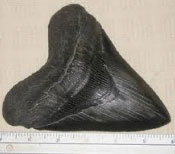 |
| Fossilized shark tooth |
Creature Feature is an online project intended to extend topical subjects in marine biology of and for our region. The loggerhead turtle (
Caretta caretta) was January’s creature. Hundreds of these animals nest on beaches in South Carolina, Georgia and North Carolina. Scientists, citizen volunteers, informal science centers and students contribute to the survival and protection of this marine reptile. Other Creature Features have focused on the invasive lionfish, the declining oyster, threatened cold-water corals, and the local blacknose shark. All Creature Features are written by Brittney Marshall and edited by Angela Bliss and Elizabeth Vernon Bell, and are archived so that educators can use this valuable resource.
The February 2011 Creature Feature will be a special paleo-creature - the extinct Megladon shark. Mark Havenstein, owner of Lowcountry Geologic, a professional full service fossil operation, and graduate of the College of Charleston, dives and collects large teeth from our coastal rivers, evidence of the Megladon’s former but significant presence in our region. Stay tuned!
COSEE SE Research Specialist Carrie Thomas is one of the featured scientists on the COSEE Scientists Making an Impact website. Thomas has a special gift for taking the complex concepts in oceanography and introducing them to non-scientists. She also provided professional review of the materials for the Climate Change Institutes described below.
| | 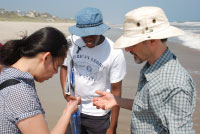 |
| Dr. Min Liu learns about North Carolina beach sands from regional teachers |
Climate Change
The COSEE SE Team convened two summer Ocean Sciences Education Leadership Institutes in 2009 and 2010, which focused on evidence for and impacts of southeastern climate change. These week-long residential professional development opportunities engaged scientist and educator participants in a variety of lab-, field- and classroom-based environments as they traveled from North Carolina State University (NCSU) in Raleigh, NC to the coast and marine labs. Topics were selected based on their relevance to and impacts on the southeastern region, and included ocean acidification, sea level change, sea temperature increases, hurricanes, and paleoclimate. Dr. Min Liu, COSEE China representative from Xiamen University, shared her research interests and observed the workshop interactions.
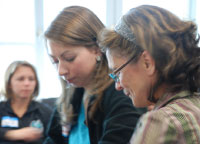 | |
Hilton Head Prep student and
teacher, Angela Taylor | |
One expectation of Institute participation requires teachers to transfer concepts to their local school district through a six-hour Professional Development at an informal education center. These events, called Ocean Awareness Days (OAD), engage new educators and present participants with resources, lessons and support to bring climate change concepts into their classrooms. The 2009 and 2010 Institutes provided 16 OADs to local communities. Connecting scientists with schools and science centers creates more partnerships. Resources from the Climate Change Institutes are located on our website. In addition, as a result of Institute interactions with the scientific community on climate change, COSEE SE has been formally brought into the Broader Impacts sections of two NSF proposals.
Basic Observation Buoy (BOB) and STEM
In our partnership with SECOORA and IOOS we continue to support innovations and investigations with the BOB project. The latest gathering of this community took place in December 2010 at Jacksonville University. In the BOB workshops, we have maintained equality and collaboration among participants - university researchers, high school students and instrument vendors meet on the same level and equally share experiences and ideas.
In this workshop, we put the spotlight on BOB applications. Three students from Hilton Head Preparatory, Beaufort High School and Charleston Magnet high schools made presentations about their STEM ventures with BOB. Sue Cook from COSEE Florida and Ivar Babb and Penny Vlahos from COSEE TEK joined this band of inventors, including researchers from University of North Florida, Kennesaw State University, UNC-Wilmington, ODU, NCSU and Jacksonville University.
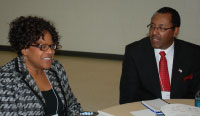 | |
Dr. Mabel Mathews, NASA with
Dr. Larry Campbell, UNC-CH | |
Broadening Participation Workshop, NCSU
On December 9-10, Carrie Thomas, Research Specialist with COSEE SE and NCSU associate professor of Marine Earth and Atmospheric Sciences, and COSEE SE PI Lundie Spence presided over a two-day workshop focused on university experiences and recommendations to increase diversity in the geosciences. Funded by NSF Opportunities for Enhancing Diversity in the Geosciences (OEDG), over 30 participants contributed ideas that will lead to proceedings designed to encourage regional collaboration. Representatives from University of Georgia, Savannah State University, South Carolina State University, University of South Carolina, University of North Carolina at Chapel Hill, UNC-Wilmington, North Carolina A & T University, Elizabeth City State University, SC Department of Natural Resources Marine Resources Research Institute, Medical University of South Carolina (MUSC), and Shodor Inc. participated. In addition, federal agency representatives from NSF (Michelle Hall), EPA (Brandon Jones), NOAA (Victoria Dancy), and NASA (Mabel Mathews) provided information about funding and their programs.
| | 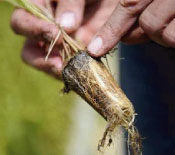 |
| Transplanting salt marsh seedling |
From Seeds to Shoreline
In January 2010, Elizabeth Vernon Bell, working with partners from the SC Department of Natural Resources (SCDNR) and Clemson Extension, began the pilot student action project From Seeds to Shoreline: Engaging Students in Salt Marsh Restoration. The objectives of this project are two-fold: 1) educate students on the importance and ecology of the salt marsh ecosystem; and 2) engage students in meaningful community stewardship. With a grant from the SC Sea Grant Consortium and support from the Clemson Extension, students participate in aspects of salt marsh restoration, including the collection of seeds in the fall, planting and cultivation of the seedlings this winter and spring, and transplanting seedlings to salt marsh shorelines in the late spring. All supplies and educational materials are provided by the partners. (For example, Clemson University is providing space in its greenhouse for over 8,000 seedlings.) After assessing this first year of the pilot, SC Sea Grant and COSEE SE will develop plans for extending this pilot to the region.
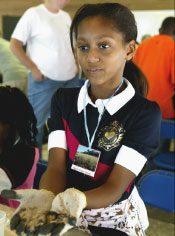 | |
Middle school scientist | |
SeaSeekers
South Carolina State University, SCDNR and COSEE SE completed a two-year NSF OEDG project connecting middle school students from Felton Laboratory School of SCSU, a member of Historically Black Colleges and Universities, with scientists from the Fort Johnson Marine Resources Center, Charleston, SC. This project, called SeaSeekers, was coordinated by Dr. Jennifer Cash and COSEE SE Team members, who worked with several components of the science workforce pipeline. Based on research and other projects focusing on increasing underrepresented populations in the geosciences workforce, SeaSeekers was designed to bring middle grade students in contact with estuarine scientists, and introduce them to scientific investigations and estuarine concepts that also align with SC’s state standards.
The key was a cadre of science undergraduate mentors who worked to make connections between the young students and the scientists. Sandra Bickerstaff, the science teacher, and Dr. Loretta Leaphart, school principal, enabled their students to make field trips to Charleston. The students were introduced to the coastal environment - many had never seen the sea – and met the scientists. The students then returned to their classroom and conducted a small series of investigations, such as examining the ability of mud snails to locate food. With the help of the undergraduate mentors, the students prepared presentations of their own research and returned to Charleston. This time, it was the students who presented to the scientists. After each presentation of the five investigations, the scientists and students interacted. Dr. Mutindi Ndunda, College of Charleston science education researcher, evaluated the project.
Among the outputs of SeaSeekers are the lessons and investigations used by mentors and students, which are located on the COSEE SE website. Ms Bickerstaff and Elizabeth Vernon Bell presented the results of the effort at meetings of the NSTA, South Carolina Science Council, and South Carolina Marine Education Association.
Ocean Literacy at the College of Charleston
The upcoming Spring 2011 semester at the College of Charleston spotlights a new course introducing the Essential Principles of Ocean Literacy to master’s level students. Instructors Elizabeth Rogers Joyner, former COSEE SE marine education specialist, and EV Bell, current COSEE SE marine education specialist, are co-teaching Introduction to Marine and Coastal Processes at the College of Charleston, part of the Science and Math for Teachers track within the college’s Master of Education program. The course syllabus uses as its foundation the Ocean Literacy Essential Principles and incorporates weekly blog entries, webquests, in-class and take home lessons, field experiences, and relevant articles. The students, mainly elementary grade level teachers, will shadow marine scientists and also build resources during the course of the semester to aid them in addressing state science standards using ocean science concepts.
Visit COSEE SouthEast!

